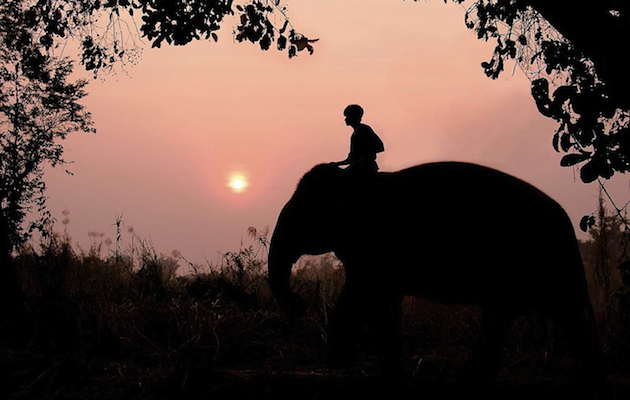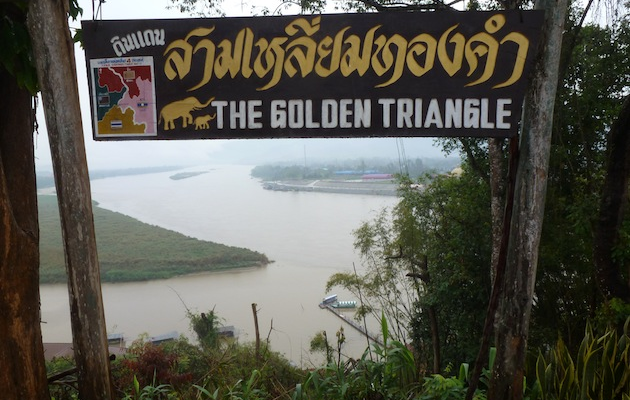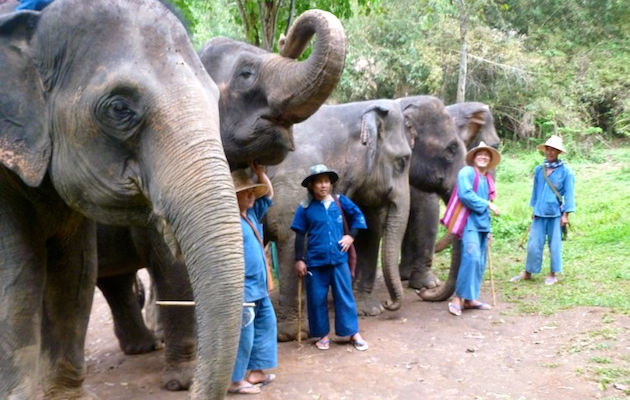From the bar, it now being pitch dark outside, and armed with a torch from my room, the steward nevertheless thought it best to summon transport to the restaurant at the other end of the resort. This arrived in the shape of a battered 1960s Landrover which I thought seemed excessive given the vehicle 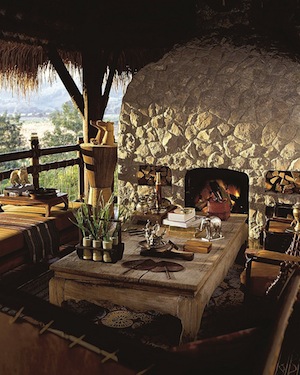 track was paved, but it still struggled unnecessarily. A golf buggy would have sufficed but then that’s hardly part of a ‘jungle’ experience.
track was paved, but it still struggled unnecessarily. A golf buggy would have sufficed but then that’s hardly part of a ‘jungle’ experience.
The menu at Nong Yao restaurant may not be a la carte (the resort is fully inclusive after all) but is certainly very well considered, with both Thai and Western choices and with a fine wine selection (two red, two white, differing each night) so much so that, past 10pm, I noticed I was the last one there, having absorbed myself in my diary and a well-charged glass. Guided back to my tent – for darkness, not excessive libation, I should point out – the full extent of being in the jungle hit me as the rain beat down on the tent canopy occasionally punctuated by a protesting pachyderm in the near distance. Strange as it may seem, comfortable in bed, cocooned by the mosquito net, it provided a strangely calming cacophony to fall asleep to.
The itinerary laid on for me for the next day looked like a relentless one indeed, though by my own choice. ‘Breakfast with elephants’ really was that. Not so watching handlers feeding these creatures as we viewed from afar, they literally joined us as we ate, our being encouraged to feed with baskets of bananas. And being so close so soon to these magnificent creatures was a fine introduction to what was to come: mahout training.
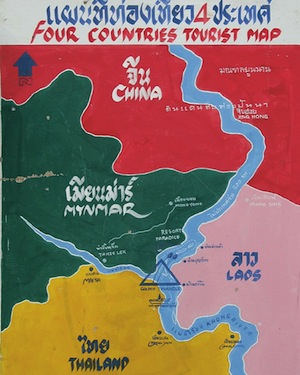 But, first, I was met by Mai. A plucky, grinning bundle of enthusiasm who was to be my guide for the morning visit to the Golden Triangle itself. Back into the jeep, transferring to a taxi on the main road we were driven to the nearby town for a visit to a local market – there are a lot of markets in Thailand – where, for my education two days previously, I was already briefed on ants’ eggs, live frogs and 1000-year old eggs. There is always something new to see, however, and Mai was always on hand to act as translator with the stall-holders – namely when talking to one butcher boiling pigs’ intestines; making stock? I enquired. No, they were being cooked to make them more presentable on the counter. What’s more, he said, they were imported from Denmark, Danish pig guts are nicer than Thais’. Who’d have thought.
But, first, I was met by Mai. A plucky, grinning bundle of enthusiasm who was to be my guide for the morning visit to the Golden Triangle itself. Back into the jeep, transferring to a taxi on the main road we were driven to the nearby town for a visit to a local market – there are a lot of markets in Thailand – where, for my education two days previously, I was already briefed on ants’ eggs, live frogs and 1000-year old eggs. There is always something new to see, however, and Mai was always on hand to act as translator with the stall-holders – namely when talking to one butcher boiling pigs’ intestines; making stock? I enquired. No, they were being cooked to make them more presentable on the counter. What’s more, he said, they were imported from Denmark, Danish pig guts are nicer than Thais’. Who’d have thought.
A tuk-tuk took us back to our cab, and ran us up to the hill at the top of the town where a small, hastily built frame made for a viewing platform for The Golden Triangle. We were standing on Thai soil. Below us the Ruak met the Mekong, on the left of which was Burma and, on the right, Laos. The point in the river where the three meet being the triangle. The mystifying allure of the name was certainly not being justified by the picture before me, however: overcast as a the weather was, misted with drizzle, a tug belched black smoke up the rusty brown Mekong and over in Laos sat an imposing Chinese-run immigration point that rather bleached the lush greenery of what was Burma and the otherwise undeveloped Laos.
Ten minutes later we were bankside and boarding a long tail into the Triangle itself where, bobbing about for a moment or two, as unremarkable as it may appear it did, oddly, feel as though we were doing something special. The moment satisfied, we shot back down the Ruak, passing a replica of the large golden Buddha from the temple on the riverbank, and back to the camp for lunch. And then it was time for the elephants.
In our tents there are two clothes racks. One is bare, for one’s own wardrobe, and on the other hangs a handful of thick blue cotton smocks and Thai slacks – the design based on those worn by fishermen – in various sizes. This is standard issue mahout attire. In addition, there’s a length of checked cloth, worn like a belt not, as you may think, to hold up one’s trousers, but to give mahout trainers something to grab you by should you look a little unsteady on the back of an elephant. Suitably kitted out, I was met by Peng, out instructor, and we were soon joined by two American couples, loud and ready to comment as is their whim – although, in fairness, most amiable and entertaining.
First, the basics: Elephant 101. Peng took us through mounting, position and so forth and, after a momentary reluctance, we stepped up. Typically, it was harder than it was made to look. My charge was Thong Kam, at 55, one of the grand dames of the troupe. There’s a command for her to kneel on her forelegs, one grabs her leathery ear, steps onto her leg and as one throws one’s own leg over, she starts to get up, her momentum helping haul you onto her back. It threw the less nimble of us and I heard panicked cries of “I can’t, I can’t!” which were dismissed, fortunately, because we all soon settled and realised we could.
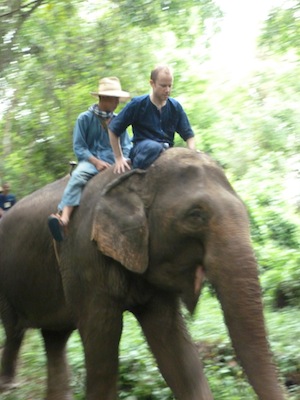 One is sat high, almost kneeling on the animal’s crown, avoiding the shoulders which would rock one back and forth as she moved; it was an exhilarating experience, and that was just the start. A short walk to the training area, we were instructed on basic commands for ‘Go’, ‘Stop’, and steering which we then practised around a slalom; it was all rather bizarre, really, but heightened as an experience because we were riding solo, not on a saddle, nor as a passenger. Here, too, I learned that Thong Kam meant “golden”, which was fitting for where we were. Once skilled in steering, we set off on a trek and any thoughts of covering some serious ground were soon spent as elephants aren’t really the speediest of creatures, not least they require constant encouragement to stick to the task at hand and not eat foliage every other step.
One is sat high, almost kneeling on the animal’s crown, avoiding the shoulders which would rock one back and forth as she moved; it was an exhilarating experience, and that was just the start. A short walk to the training area, we were instructed on basic commands for ‘Go’, ‘Stop’, and steering which we then practised around a slalom; it was all rather bizarre, really, but heightened as an experience because we were riding solo, not on a saddle, nor as a passenger. Here, too, I learned that Thong Kam meant “golden”, which was fitting for where we were. Once skilled in steering, we set off on a trek and any thoughts of covering some serious ground were soon spent as elephants aren’t really the speediest of creatures, not least they require constant encouragement to stick to the task at hand and not eat foliage every other step.
Our course took us through scrub and forest, for about an hour, until we emerged riverside. Unperturbed by the steep muddy bank – they are surprisingly nimble animals – we were soon knee deep (ours, not theirs) in water and decidedly dunked and sprayed, much to the delight of the handlers. Suitably drenched, we trekked on, back to the camp, to slide off over the tops of their heads and waddle like John Wayne (us, and them) to the joys of a warm outdoor shower back at tent, feeling very accomplished having, unbelievably, ridden elephants in the forests of northern Thailand. I’m pinching myself as I write that even now.
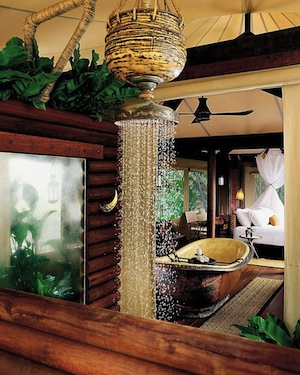 The shower was short-lived as yet another spa treatment awaited me before supper. Situated in the rooftops, above the gorge that cuts through the camp, the real highlight is that it is open to the elements. The ‘mahout recovery’ massage was, alas, neither as pleasing nor as therapeutic as I’d hoped but to have such a thing in such a setting was a pleasure indeed.
The shower was short-lived as yet another spa treatment awaited me before supper. Situated in the rooftops, above the gorge that cuts through the camp, the real highlight is that it is open to the elements. The ‘mahout recovery’ massage was, alas, neither as pleasing nor as therapeutic as I’d hoped but to have such a thing in such a setting was a pleasure indeed.
From one indulgence to another, I just had time for a lemongrass martini before dinner and this time my companion was Josh, an academic American and founder of Think Elephants, a charity working with the camp whose aim is understanding the cognitive acuity of these animals. His was a convincing case and we shared beliefs on environmental and ecological matters but, alas, as he invited me to their research facility the next morning I knew I’d never make it as my only window was after my second date with Thong Kam, this time for a dawn trek – one of the camp’s newest activities.
Concludes on page 3…

